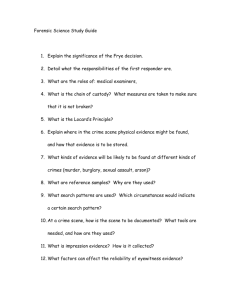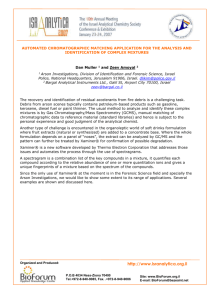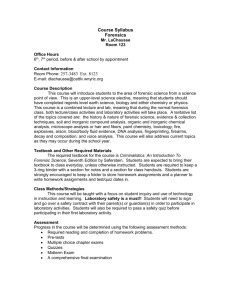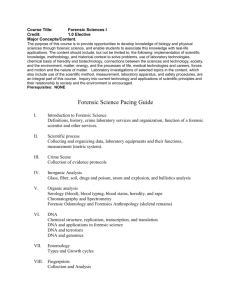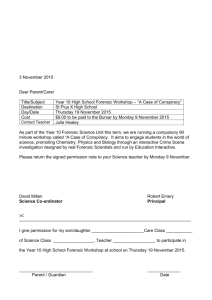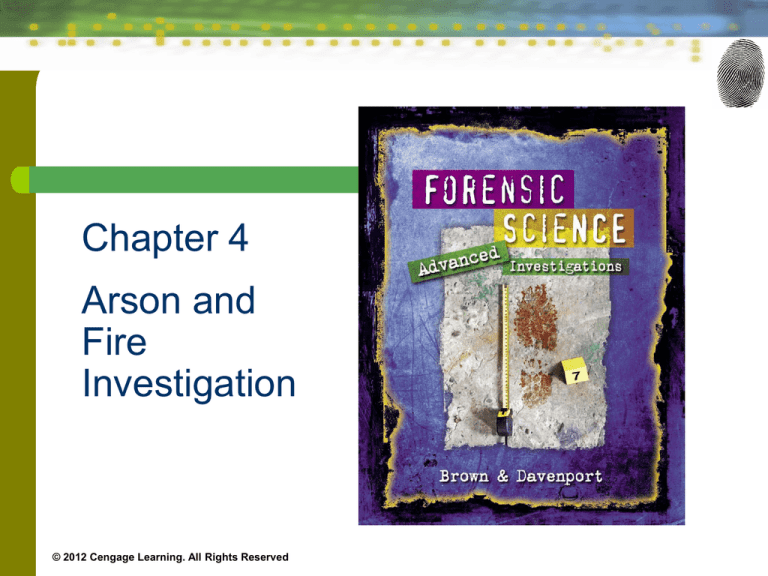
Chapter 4
Arson and
Fire
Investigation
© 2012 Cengage Learning. All Rights Reserved
Introduction—Objectives
1. Define combustion reactions.
2. Discuss the four factors that are required to
ignite and maintain a fi re.
3. Explain the conditions in which fuels will
burn.
4. Examine reasons why arson is difficult to
detect.
5. Identify the four categories of fire.
2
Forensic Science II: Arson and Fire Investigation, Chapter 4
© 2012 Cengage Learning. All Rights Reserved
Introduction—Objectives
6. Evaluate the significance of burn patterns
discovered at an arson investigation.
7. Discuss the proper methods for detecting,
collecting, preserving, and analyzing arson
evidence.
8. Describe the psychological profile of an
arsonist.
9. Examine the various motives for arson.
3
Forensic Science II: Arson and Fire Investigation, Chapter 4
© 2012 Cengage Learning. All Rights Reserved
Introduction—Vocabulary
o
o
o
o
o
4
accelerant - in fire investigation, any material used
to start or sustain a fire; the most common are
combustible liquids
arson - the intentional and illegal burning of property
combustion reaction – oxidation reaction that
involves oxygen and that releases heat and light
exothermic reaction – chemical reaction that
releases heat
heat of combustion - excess heat that is given off in
a combustion reaction
Forensic Science II: Arson and Fire Investigation, Chapter 4
© 2012 Cengage Learning. All Rights Reserved
Introduction—Vocabulary
o
o
o
o
5
hydrocarbon - any compound consisting only of
hydrogen and carbon
oxidation reaction - the complete or partial loss of
electrons or gain of oxygen
pyrolysis - decomposition of organic matter by heat
in the absence of oxygen
substrate control - a similar, but uncontaminated,
sample; used for making comparisons
Forensic Science II: Arson and Fire Investigation, Chapter 4
© 2012 Cengage Learning. All Rights Reserved
Happy Land Fire
o
o
o
o
o
6
Julio Gonzalez and Lydia Feliciano dated off
and on for six years.
When Lydia ended the relationship, Julio set
fire to the Happy Land Club in the Bronx.
87 people were trapped and died.
Julio purchased the accelerant at a local
station.
Julio’s home and shoes smelled of gasoline.
Forensic Science II: Arson and Fire Investigation, Chapter 4
© 2012 Cengage Learning. All Rights Reserved
Chemistry of Fire (Obj 4.1, 4.2, 4.3)
o
o
Fire — a rapid oxidation reaction that
involves a combustible material
Oxidation — the complete or partial loss of
electrons or the gain of oxygen
2NA + Cl2 2NaCl
7
Forensic Science II: Arson and Fire Investigation, Chapter 4
© 2012 Cengage Learning. All Rights Reserved
Combustion
o
o
o
8
Combustion reactions — oxidation reactions
that involve oxygen and produce flames
Heat of combustion — excess heat energy
Exothermic reactions — chemical reactions
that release heat
Forensic Science II: Arson and Fire Investigation, Chapter 4
© 2012 Cengage Learning. All Rights Reserved
The Fire Tetrahedron
Four ingredients are
required to start a fire
and keep it burning
•
•
•
•
9
Oxygen
Fuel
Heat
Chain reaction
Forensic Science II: Arson and Fire Investigation, Chapter 4
© 2012 Cengage Learning. All Rights Reserved
Flash Point & Ignition Temperature
o
o
o
o
o
10
Most accelerants are hydrocarbons in a gas
state
Hydrocarbons are compounds that are made
of only hydrogen and carbon atoms
— gasoline, kerosene, lighter fluid
In a gas state, molecular bonding is weaker
Vaporization — liquid changes to gas
Flash point — lowest temperature at which
vaporization occurs
Forensic Science II: Arson and Fire Investigation, Chapter 4
© 2012 Cengage Learning. All Rights Reserved
Flash Point & Ignition Temperature
11
Forensic Science II: Arson and Fire Investigation, Chapter 4
© 2012 Cengage Learning. All Rights Reserved
Pyrolysis
o
o
12
pyrolysis - decomposition of organic matter
by heat in the absence of oxygen
The vapors given off from the resins in wood
are flammable and will burn.
Forensic Science II: Arson and Fire Investigation, Chapter 4
© 2012 Cengage Learning. All Rights Reserved
Arson is Difficult to Prove
o
o
o
o
13
The crime is usually carefully planned.
The arsonist leaves the scene before anyone
notices a fire.
The fire destroys evidence.
Extinguishing the fire also destroys evidence.
Forensic Science II: Arson and Fire Investigation, Chapter 4
© 2012 Cengage Learning. All Rights Reserved
Function of a Fire Investigator
o
o
o
Investigation must begin quickly, before
evidence is lost
Find the fire’s point of origin
Examine possible causes
•
•
o
14
Accidental
Arson
Classify the fire
Forensic Science II: Arson and Fire Investigation, Chapter 4
© 2012 Cengage Learning. All Rights Reserved
Function of a Fire Investigator
15
Forensic Science II: Arson and Fire Investigation, Chapter 4
© 2012 Cengage Learning. All Rights Reserved
Determining Cause
16
Forensic Science II: Arson and Fire Investigation, Chapter 4
© 2012 Cengage Learning. All Rights Reserved
Determining Cause
17
Forensic Science II: Arson and Fire Investigation, Chapter 4
© 2012 Cengage Learning. All Rights Reserved
Collecting the Evidence
o
o
o
o
18
Begin immediately; no warrant required
Collect 3-4 liters of ash from point of origin
and other suspected areas
Use portable vapor detectors, or sniffers
Use trained dogs to sniff
Forensic Science II: Arson and Fire Investigation, Chapter 4
© 2012 Cengage Learning. All Rights Reserved
Collecting the Control
o
o
o
o
19
Place each sample in its own container
Collect a substrate control — a debris
sample that has not been contaminated by
the accelerant
Comparisons to the substrate control may
help prove an accelerant was used
Some products may look like accelerants
when burned
Forensic Science II: Arson and Fire Investigation, Chapter 4
© 2012 Cengage Learning. All Rights Reserved
Packaging the Debris
o
o
20
Use airtight containers such as a new clean
paint can and lid
Leave head space at the top of the can
Forensic Science II: Arson and Fire Investigation, Chapter 4
© 2012 Cengage Learning. All Rights Reserved
Finding the Igniter
o
o
o
o
o
21
Matches — often burns in the fire
Cigarette lighters — often removed by
arsonist
Molotov cocktail — may leave glass
fragments
Faulty electrical wiring — an arc causes a
predictable pattern
Knowing the igniter helps form the criminal
profile
Forensic Science II: Arson and Fire Investigation, Chapter 4
© 2012 Cengage Learning. All Rights Reserved
Lab Analysis
o
o
Heat the debris container to collect vapors in
the head space
Direct headspace extraction procedure
•
•
o
Passive headspace extraction procedure
•
•
•
•
22
Remove vapors with a syringe
Analyze vapors with gas chromatography
Suspend a charcoal-coated strip inside the can
Replace lid
Heat container 4-16 hours at 50-80oC
Charcoal absorbs the vapor
Forensic Science II: Arson and Fire Investigation, Chapter 4
© 2012 Cengage Learning. All Rights Reserved
Lab Analysis
Passive headspace extraction procedure
23
Forensic Science II: Arson and Fire Investigation, Chapter 4
© 2012 Cengage Learning. All Rights Reserved
Psychology of an Arsonist
o
o
o
Sense of power
An emotional high
No typical arsonist; possible characteristics:
• Less than 25 y.o.
• Father not in the home
• Domineering mother
• Academically challenged
• Emotionally and/or
psychologically disabled
24
Forensic Science II: Arson and Fire Investigation, Chapter 4
© 2012 Cengage Learning. All Rights Reserved
• Unmarried
• Living with parents
• Inadequacy, insecurity
• Fascination with fire
• Alcoholism
• Parental neglect or abuse
Motives for Arson
o
o
o
o
o
o
25
Financial gain — insurance fraud
Revenge, spite
Excitement
Vanity, hero syndrome
Crime concealment — destroy evidence
Vandalism
Forensic Science II: Arson and Fire Investigation, Chapter 4
© 2012 Cengage Learning. All Rights Reserved
Chapter Summary
o
o
o
o
26
Fire is an oxidation reaction that involves a
combustible material. Not all oxidation reactions
produce fire.
The fire tetrahedron represents the four
requirements for sustained fire—oxygen, fuel, heat,
and a chain reaction.
Most fuels are hydrocarbons and typically have very
high ignition temperatures.
The ignition temperature is when a fuel will light and
continue to burn even if the heat source is removed.
Forensic Science II: Arson and Fire Investigation, Chapter 4
© 2012 Cengage Learning. All Rights Reserved
Chapter Summary
o
o
o
o
27
The initial focus is to find the fire’s point of origin
The burn pattern helps determine whether the fire
was natural, accidental, or deliberate.
Ash and debris are collected from the point of origin
and any other suspected area.
Each sample of debris is placed in a separate airtight
container.
Forensic Science II: Arson and Fire Investigation, Chapter 4
© 2012 Cengage Learning. All Rights Reserved
Chapter Summary
o
o
o
28
For comparison purposes, investigators also collect
a substrate control.
Two methods of collecting accelerant vapors for
analysis are:
• direct headspace extraction procedure and
• vapor concentration.
Gas chromatography is used to analyze the
accelerant residue — comparing the lab
chromatogram with one of known hydrocarbons.
Forensic Science II: Arson and Fire Investigation, Chapter 4
© 2012 Cengage Learning. All Rights Reserved
Chapter Summary
o
o
29
Arsonists tend to exhibit a set of characteristics that
helps investigators focus their search.
Most of the motives fit into six broad categories —
financial gain, revenge, excitement, vanity, crime
concealment, and vandalism.
Forensic Science II: Arson and Fire Investigation, Chapter 4
© 2012 Cengage Learning. All Rights Reserved

